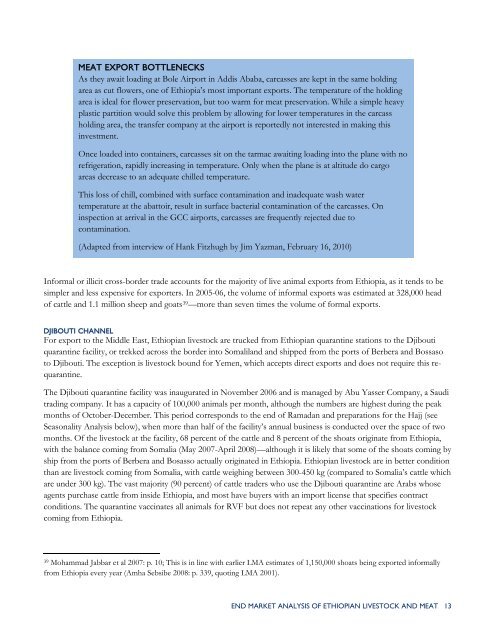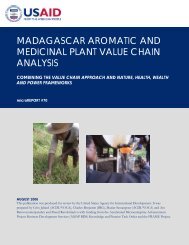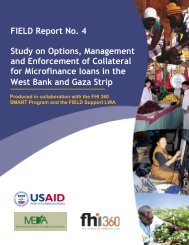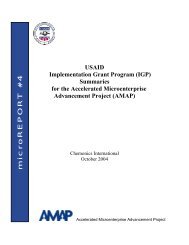End Market Analysis of Ethiopian Livestock and ... - USAID Microlinks
End Market Analysis of Ethiopian Livestock and ... - USAID Microlinks
End Market Analysis of Ethiopian Livestock and ... - USAID Microlinks
Create successful ePaper yourself
Turn your PDF publications into a flip-book with our unique Google optimized e-Paper software.
MEAT EXPORT BOTTLENECKS<br />
As they await loading at Bole Airport in Addis Ababa, carcasses are kept in the same holding<br />
area as cut flowers, one <strong>of</strong> Ethiopia’s most important exports. The temperature <strong>of</strong> the holding<br />
area is ideal for flower preservation, but too warm for meat preservation. While a simple heavy<br />
plastic partition would solve this problem by allowing for lower temperatures in the carcass<br />
holding area, the transfer company at the airport is reportedly not interested in making this<br />
investment.<br />
Once loaded into containers, carcasses sit on the tarmac awaiting loading into the plane with no<br />
refrigeration, rapidly increasing in temperature. Only when the plane is at altitude do cargo<br />
areas decrease to an adequate chilled temperature.<br />
This loss <strong>of</strong> chill, combined with surface contamination <strong>and</strong> inadequate wash water<br />
temperature at the abattoir, result in surface bacterial contamination <strong>of</strong> the carcasses. On<br />
inspection at arrival in the GCC airports, carcasses are frequently rejected due to<br />
contamination.<br />
(Adapted from interview <strong>of</strong> Hank Fitzhugh by Jim Yazman, February 16, 2010)<br />
Informal or illicit cross-border trade accounts for the majority <strong>of</strong> live animal exports from Ethiopia, as it tends to be<br />
simpler <strong>and</strong> less expensive for exporters. In 2005-06, the volume <strong>of</strong> informal exports was estimated at 328,000 head<br />
<strong>of</strong> cattle <strong>and</strong> 1.1 million sheep <strong>and</strong> goats39—more than seven times the volume <strong>of</strong> formal exports.<br />
DJIBOUTI CHANNEL<br />
For export to the Middle East, <strong>Ethiopian</strong> livestock are trucked from <strong>Ethiopian</strong> quarantine stations to the Djibouti<br />
quarantine facility, or trekked across the border into Somalil<strong>and</strong> <strong>and</strong> shipped from the ports <strong>of</strong> Berbera <strong>and</strong> Bossaso<br />
to Djibouti. The exception is livestock bound for Yemen, which accepts direct exports <strong>and</strong> does not require this requarantine.<br />
The Djibouti quarantine facility was inaugurated in November 2006 <strong>and</strong> is managed by Abu Yasser Company, a Saudi<br />
trading company. It has a capacity <strong>of</strong> 100,000 animals per month, although the numbers are highest during the peak<br />
months <strong>of</strong> October-December. This period corresponds to the end <strong>of</strong> Ramadan <strong>and</strong> preparations for the Hajj (see<br />
Seasonality <strong>Analysis</strong> below), when more than half <strong>of</strong> the facility’s annual business is conducted over the space <strong>of</strong> two<br />
months. Of the livestock at the facility, 68 percent <strong>of</strong> the cattle <strong>and</strong> 8 percent <strong>of</strong> the shoats originate from Ethiopia,<br />
with the balance coming from Somalia (May 2007-April 2008)—although it is likely that some <strong>of</strong> the shoats coming by<br />
ship from the ports <strong>of</strong> Berbera <strong>and</strong> Bosasso actually originated in Ethiopia. <strong>Ethiopian</strong> livestock are in better condition<br />
than are livestock coming from Somalia, with cattle weighing between 300-450 kg (compared to Somalia’s cattle which<br />
are under 300 kg). The vast majority (90 percent) <strong>of</strong> cattle traders who use the Djibouti quarantine are Arabs whose<br />
agents purchase cattle from inside Ethiopia, <strong>and</strong> most have buyers with an import license that specifies contract<br />
conditions. The quarantine vaccinates all animals for RVF but does not repeat any other vaccinations for livestock<br />
coming from Ethiopia.<br />
39 Mohammad Jabbar et al 2007: p. 10; This is in line with earlier LMA estimates <strong>of</strong> 1,150,000 shoats being exported informally<br />
from Ethiopia every year (Amha Sebsibe 2008: p. 339, quoting LMA 2001).<br />
END MARKET ANALYSIS OF ETHIOPIAN LIVESTOCK AND MEAT 13





